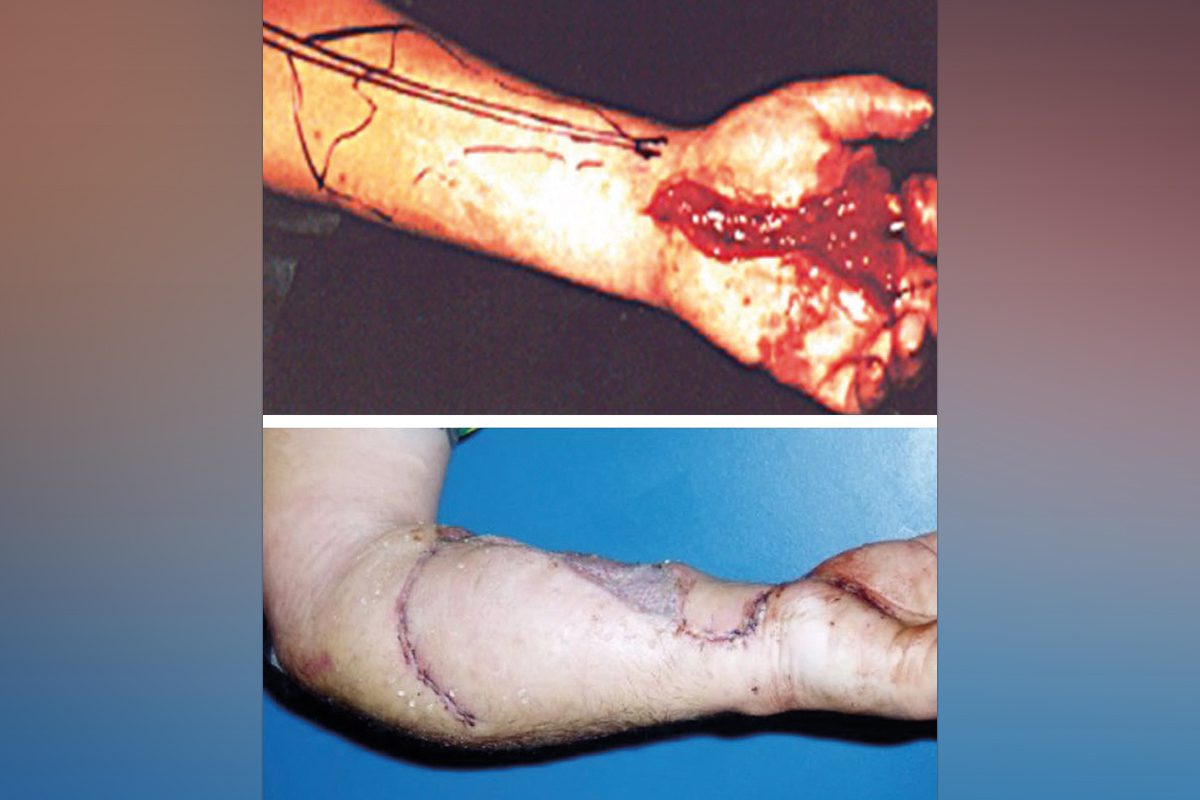Medical research commissioned by the Water Jetting Association has led to the publication of the most comprehensive guidance ever created for the management of high-pressure fluid injection injuries.
The guidance is set to transform the emergency medical response to water jet injuries, greatly reducing the risk of death, long-term disability or unnecessarily prolonged periods of recovery.
Water jetting is used widely in resource management. Applications include: standard pressure washing; high pressure water jetting to defoul equipment and structures; sewer and tank cleaning; materials cutting; and hydrodemolition.
In August 2017, a drainage operative in Canada was killed when he was struck on the neck by a water jet. The system had not been fitted with an automatic shut-off device. The contractor was fined £85,000.
David Kennedy, Director of the Water Jetting Association (WJA), which funded the new injury research, said: “This represents a step change in our understanding of how to treat high-pressure fluid injection injuries.
“Employers, first responders, paramedics and hospital medical teams have, for the first time, clear guidelines on the optimum treatment protocols for patients from first-line response through to definitive hospital care.
“Since the research paper detailing the findings has been published, it has been downloaded hundreds of times around the world, is already likely to be having an impact on how patients are treated.
“The new set of ‘Water Jetting Injury Management Guidelines’ allow us to update the medical advice in our Codes of Practice. We’ll do all we can to share these guidelines with stakeholders who can help improve emergency treatment and the survivability of operatives in our industry should a serious incident occur.”
The research paper – “Management of industrial high-pressure fluid injection injuries (HPFII): the Water Jetting Association (WJA) experience with water-driven injuries” has appeared in the European Journal of Trauma and Emergency Surgery.
Its authors comprised specialists in intensive care and emergency medicine, including Dr Sancho Rodriguez-Villar of Kings College Hospital, London, Senior Clinical Advisor to the WJA.
They began by reviewing all English-language scientific research from 1937 to 2018, the most extensive literature review in this field ever undertaken.
They were given access to the WJA’s database of advisory alerts detailing adverse incidents from around the world. The WJA also helped them contact and interview people who had experienced relevant injuries.
The study found that the unique nature of HPFII injuries makes them look less serious than they are. This often leads to delays in patients receiving the correct emergency treatment, often with serious long-term consequences.
Dr Sancho Rodriguez-Villar said: “The evidence shows that, without early and correct intervention, the outcome for those injured is often catastrophic, including death, loss of limbs and long-term disability.
“Following this research, we strongly advise all parties involved to observe the WJA’s newly updated guidelines for the management of high-pressure injection injuries.”
The two main and most common injuries that occur during water jetting are trauma caused by an uncontrolled hose striking the body or by the puncturing of the skin by a jet of fluid under pressure, known as hydraulic fluid injection.
Hydraulic fluid injection can occur at pressures as low aa 7 bar, or 100 pounds per square inch (psi), far lower than the pressure achieved by many over-the-counter water jetting machines. Ultra-high-pressure water jetting can exceed 2,500 bar, or 36,259 psi.
Water jet injuries commonly have very small entrance wounds and no exit wounds, which can mask the seriousness of the “extensive disruption” of deeper tissues that can be caused, said the researchers.
Debris and bacteria can be also carried far into the body by the jet of fluid, increasing the risk of serious infection and other problems that need to be considered carefully as part of emergency treatment programmes.
The researchers said: “High pressure water jet injuries should always, without exception, be considered contaminated wounds and treated as surgical emergencies.”
This should include a period of medical observation. However, the researchers observed: “Even though many members of the WJA carry a medical card alerting the medical staff of the potential injuries, in many cases, patients are discharged home from the emergency department without even an observation period.”
The study concluded: “A lack of comprehension of the potential severity of injuries is still the main obstacle to early and effective treatment. This appears largely due to the initial apparently minor nature of the presentation of an injury that can, unfortunately, have catastrophic consequences, such as amputation or death.”
An algorithm created by the research team on behalf of the WJA provides, for the first time, a step-by-step guide to the most effective treatment for a HPFII patient at each stage of the emergency response.
Detailed recommendations, incorporated in the algorithm, include:
• As part of their first aid response, operational water jetting teams should have access to trauma kits specifically to prevent blood loss
• Individuals who experience HPFIIs, and those responsible for their wellbeing, should be trained to alert medical personnel about the serious nature of the injuries and signpost the WJA management guidelines.
• All HPFIIs should always be treated as severe traumas in a tertiary specialist hospital whenever possible
• Evacuation by air ambulance to a trauma centre with surgical facilities must be considered in the early stages
• Early access to CT and MRI scans should be obtained to assess internal injuries
• All wounds should be treated as if they are contaminated – so kept open and surgically cleaned, in stages if necessary
• Patients should be kept under an appropriate period of medical observation
• Wound swabs and tissue samples should be taken as soon as possible and sent for microbiological and histological examination.
The WJA will now actively promote the research and the treatment algorithm through its members and stakeholders to implement the research recommendations and so improve safety standards for water jetting operatives.
David Kennedy said: “Thanks to the high health and safety standards observed by our members, underpinned by WJA Codes of Practice and high-quality training delivered by WJA-approved trainers, water jet injuries are not common.
“However, there is no room for complacency. That’s why we commissioned this research. We want to reduce the risk of fatal and life-changing injury, and to safeguard water jetting operatives across the world, and this research and its findings will assist us greatly in doing that.”






